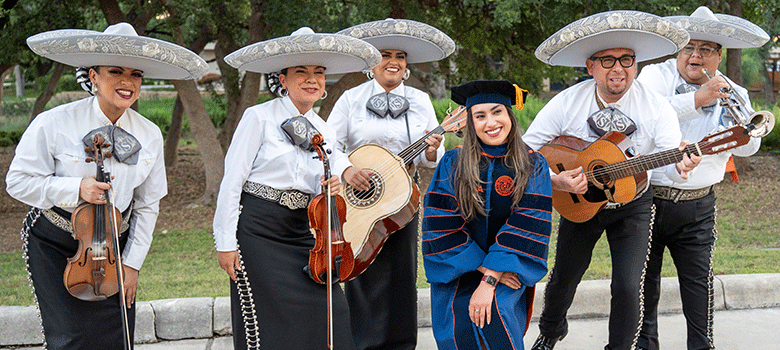
This student crossing the stage exhibits the gold cord that signifies graduation with honors and the tri-colored tassel that signifies he has earned a bachelor’s degree.
MAY 6, 2024 — During a typical UTSA Commencement celebration, everyone is wearing a cap and gown but some look very different than others. UTSA Today has tapped into the history behind the university’s academic regalia to learn what the different colors and styles represent.
The tradition of the academic dress dates back nearly eight centuries. In medieval Europe, all townsmen wore long, flowing robes or gowns. The materials and colors varied greatly, according to the wealth and rank of the individual and were governed by royal decree. Gradually, distinctive gowns were developed for the various professions, trades and guilds. Today, this tradition remains for gowns of religious orders and judiciary and in academic regalia.
Through the years, great diversity in color and style of cap, gown and hood have evolved. In 1895, a commission was established to develop a uniform code for academic dress. Today, the gowns, hoods and mortarboards worn by the graduating students of most institutions, including UTSA, follow this code.
At UTSA, the gowns and mortarboards are navy blue, one of the university’s official colors.

This doctoral graduate celebrates her milestone with the mariachis that are a tradition at UTSA’s Commencement ceremonies. Notice the flowing sleeves and velvet stripes on the gown, as well as the gold bullion tassel.
The style of the gowns vary depending on the degree the student receives. The sleeves of the gowns worn by master’s degree recipients are square at the end.
The gowns of doctoral degree recipients have flowing sleeves with three bars of velvet and velvet facing down the front with the UTSA seal. The velvet trim is five inches wide for the doctoral degree. The color of the velvet border indicates the degree and aligns with the graduates’ tassel colors.
The biggest difference in regalia can be found in the hood, which identifies the graduate degree and institution from which it was awarded. For master’s students, the hood is short. For those receiving a doctoral degree, the hood is longer and lined with silk in the official colors of the student’s institution. The UTSA hoods are blue and lined in orange with one white chevron.
The academic caps also have their own special meanings. Developed in the 15th century, some caps were stiff, some soft, some square and some round with a tuft in the center.
The tassel used today is an elaboration of the tuft. While some institutions still use the round caps, most institutions, including UTSA, have adopted the mortarboard style that comes from Oxford University. Students earning terminal degrees wear a tam instead of a mortarboard.
For a bachelor’s degree, the tassel's colors represent the university in a tricolor of orange, blue and white. The tassel color worn by master’s degree recipients indicates the discipline in which the degree has been earned. Those graduating with a doctoral degree wear a gold bullion tassel.
The gold cord, worn by some undergraduate students, indicates graduation with honors: summa cum laude, which include graduates with a GPA of 3.90 to 4.00; magna cum laude, which is awarded to those with a GPA of 3.75 to 3.89 or cum laude, which includes graduates with a GPA of 3.50 to 3.74.
Graduates also wear one or more stoles, indicating individual achievements such as being a student in Honors College, a veteran or a first-generation college student.
UTSA leadership and faculty wear robes representing the university where they earned their highest degree. President Taylor Eighmy’s regalia, for example, is from the University of New Hampshire, where he earned his Ph.D. in Environmental Engineering. Eighmy’s orange hood likewise signifies his engineering degree.
Eighmy also wears the UTSA Presidential Medallion, which symbolizes the authority and responsibility vested in the UTSA President. The brass medallion has the university’s seal on one side and the words “Presented by the UTSA Development Board in honor of the University’s 25th anniversary—1994” on the other side.

President Eighmy's regalia represents where he earned his Ph.D. in environmental engineering. He also wears the UTSA Presidential Medallion.
Blue Violet: architecture, urban and regional planning
Brown: art, interior design
Citron: American studies, anthropology, bicultural and bilingual studies, geography, Mexican American Studies, social work
Copper: economics
Crimson: communication
Dark Blue: justice policy, philosophy, political science
Drab: business, data analytics
Gold: criminal justice, psychology
Golden Yellow: sciences, mathematics
Light Blue: education
Pink: music
Orange: engineering
Peacock Blue: public administration
Sage: health, kinesiology, public health
White: classical studies, history, humanities, multidisciplinary studies, sociology, languages, women's studies
UTSA Today is produced by University Communications and Marketing, the official news source of The University of Texas at San Antonio. Send your feedback to news@utsa.edu. Keep up-to-date on UTSA news by visiting UTSA Today. Connect with UTSA online at Facebook, Twitter, Youtube and Instagram.
Enjoy snacks while connecting with Adobe reps and student ambassadors. Download or log into the Adobe Express app to snag swag and unlock exclusive back-to-school templates. It’s a fun, fast way to get creative and start the school year with bold moves.
Central Plaza, Main CampusCelebrate the merger of UTSA and UT Health San Antonio with a pop-up featuring free t-shirts, exclusive swag, and interactive photo opportunities. Open to all students, faculty and staff. Supplies are limited!
Sombrilla Plaza, Main CampusHuddle Against Hunger is a fundraising competition with Texas State that benefits our Roadrunner Pantry. Donations this week will help UTSA earn additional prize monies provided by RBFCU.
In-Person and VirtualJoin UTSA Libraries for an update on federal public access policies and how the library can assist with compliance.
Virtual EventWe invite you to join us for Birds Up! Downtown, an exciting welcome back event designed to connect students with the different departments at the Downtown Campus. Students will have the opportunity to learn about some of the departments on campus, gain access to different resources, and collect some giveaways!
Bill Miller PlazaThere are many citation managers. Which one is right for you? This workshop will explain what a citation manager is and how it can help you organize your citations, insert citations as you write your paper, and generate your bibliography.
Virtual EventPubMed is an essential database for anyone conducting biomedical or health-related research. This workshop will teach attendees how to effectively navigate this free resource and locate peer-reviewed articles using advanced search features, MeSH subject headings, and Boolean operators.
Virtual EventThe University of Texas at San Antonio is dedicated to the advancement of knowledge through research and discovery, teaching and learning, community engagement and public service. As an institution of access and excellence, UTSA embraces multicultural traditions and serves as a center for intellectual and creative resources as well as a catalyst for socioeconomic development and the commercialization of intellectual property - for Texas, the nation and the world.
To be a premier public research university, providing access to educational excellence and preparing citizen leaders for the global environment.
We encourage an environment of dialogue and discovery, where integrity, excellence, respect, collaboration and innovation are fostered.